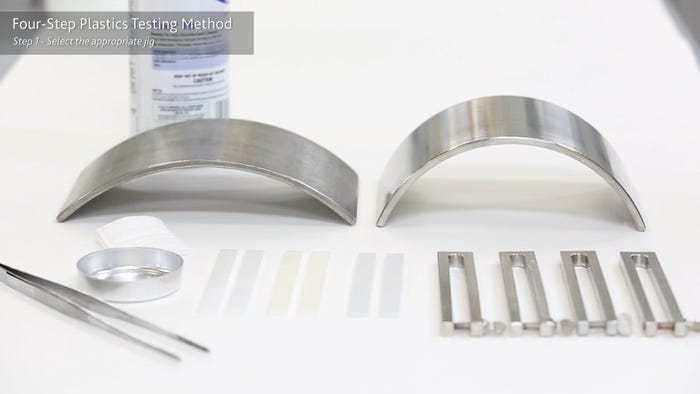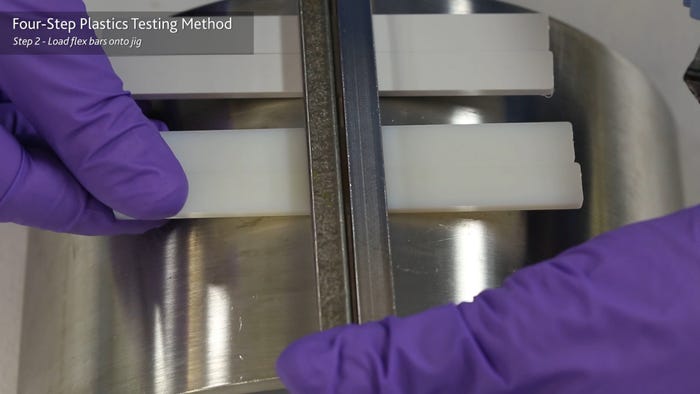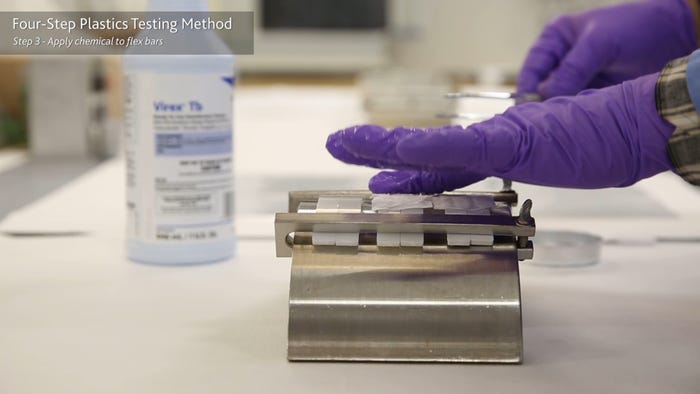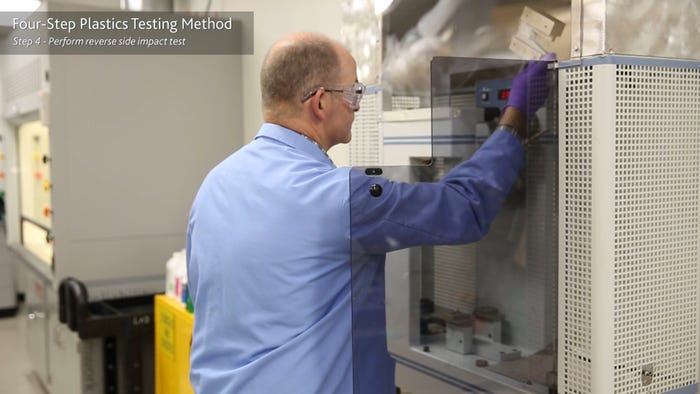July 5, 2017
Materials provider has developed a testing protocol for evaluating the effects of disinfectants on plastics.
Following is Eastman's four-step plastics testing method: |
|
Step 1: Select the appropriate jig |
Never have medical device housings had to be so durable. As hospitals work to prevent healthcare-associated infections, clinicians are using newer, more aggressive disinfectants to clean the surfaces of reusable devices. These disinfectants may take a toll on some materials, leaving these devices vulnerable to breakage during routine hospital use.
Devices get "bumped and dropped" in hospitals, but "clinicians shouldn't have to be concerned about that when saving lives," said Ellen Turner, global market development manager, specialty plastics in medical devices, Eastman. And because of "healthcare reform, hospitals need devices to last longer," she added. Nonetheless, "clinical and biomedical engineers have started seeing failures in plastic devices and have had to fix broken equipment," she told Qmed.
Better materials testing is needed, said Turner, and that requires cooperation among many stakeholders. "Clinical engineers have been battling these issues on the frontlines on their own," Turner said. "But if all of us work together along the value chain, testing and materials innovation will help address these issues."
One of the challenges is that there hasn't really been a standard test for durability, said Turner. "Some have soaked products then measured weight change, others have had labs wipe down products thousands of times," she said. And "many clinical engineers have conducted their own internal studies to identify which disinfectants have given them more trouble. But historically, most have reported only visual inspections as test results."
|
Step 2: Load flex bars onto jig |
Eastman advises that medical device designers and other stakeholders measure impact resistance and durability of device materials after exposure to disinfectants. To this end, the company has developed a new four-step testing protocol incorporating such evaluations and recently shared that approach at AAMI's recent conference in Austin, TX.
"When we launched Tritan, which can be used for electronic housings and other applications, we saw that the current means of [disinfectant] testing was inadequate," she said. "The question is, how do you quickly test to differentiate material options? We decided to add a test that went beyond appearance."
Eastman's new protocol, which could be used for MRI coils, ultrasound probes, buttons, handles, portable pieces of equipment, and other components, could help fill that gap in testing. During the test, plastic samples are secured on a fixed-strain jig, exposed to a disinfectant, and then placed in a bag for at least 24 hours. After exposure, the samples are then subjected to a fourth step, a reverse-side impact test. Based on "modified" ASTM D543 and ASTM D4812 standards, this additional step means that "you are better able to predict the reliability of a device after exposure," Eastman reports.
Such testing can help differentiate the impact resistance of different plastics, Turner said. "We were amazed that some plastics looked good visually, but impact tests showed a loss of 50% to 90% in impact strength," she said. "In further testing, at points of high stress in designs, we saw breakdowns. For instance, we saw breakdown at screw bosses where housings were assembled. We learned that it is impossible to completely design out stress, but failures can be reduced in those high stress areas with more clinically resistant plastics."
|
Step 3: Apply chemical to flex bars |
Clorox Healthcare, a provider of hospital disinfectants, has endorsed the four-step testing protocol as an "effective tool for assessing the integrity of a device or surface after repeated cleaning and disinfection," Eastman stated in a news release.
Clorox Healthcare representatives joined Eastman at its AAMI booth to discuss the issue of infection control with attendees. "Eastman and Clorox Healthcare are taking an honest approach to solving the problem," Turner said, and they believe the answer lies in a "rigorous approach to testing materials." Explained Laurie Rabens, Clorox Healthcare's senior product manager -- Marketing, in the statement: "Eastman's testing shows that the type of plastic used in these sensitive applications is critical to patient safety and device reliability."
And rather than promote any one material, Turner says that Eastman is "trying to help the market understand what needs to be done to be able to resist stress and strain combined with disinfecting protocols. Over time, the industry has gotten comfortable with certain plastics, but are they well suited? Chemical resistance is an area that needs more focus." If an infusion device cracks after repeated disinfection, patients and clinicians could be exposed to infection, she added.
Turner and Rabens would ultimately like to see standards developed by the industry. "Going forward with Clorox Healthcare on this four-step test method is not the end of the story, but the beginning. It gives the industry a good start to understand more about materials degradation and better test methods," she said. "We're doing our part, but the entire value chain has to realize that clinicians have a problem that we can solve together."
|
Step 4: Perform reverse side impact test |
Eastman also urges clinical engineers to include in their RFIs and RFPs requests for devices that can withstand a broader spectrum of disinfectants and aggressive use conditions because of new material choices.
Eastman outlines the four-step process in a video comparing the performance of Eastman Tritan copolyester with other commonly used materials that include polycarbonate, polycarbonate/ABS, polycarbonate/PBT, and Polycarbonate/PET.
Eastman will be exhibiting at MD&M West held February 6-8, 2018, in Anaheim, CA.
Daphne Allen is executive editor of Pharmaceutical & Medical Packaging News and a contributor to MD&DI and Qmed. Reach her at [email protected] and on Twitter at @daphneallen
About the Author(s)
You May Also Like








